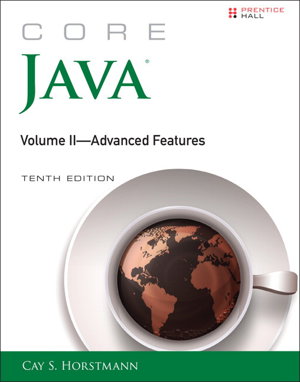| Sat | 10am – 5pm |
| Sun | 12pm – 4pm |
| Mon | 9am – 5:30pm |
| Tue | 9am – 5:30pm |
| Wed | 9am – 5:30pm |
| Thu | 9am – 5:30pm |
| Fri | 9am – 5:30pm |
Ask our staff anything about our shop or products, or share your feedback.

PublishedPrentice Hall Australia, December 2016 |
ISBN9780134177298 |
FormatSoftcover, 1088 pages |
Dimensions23cm × 18cm × 5cm |
Core Java (R) has long been recognised as the leading, no-nonsense tutorial and reference for experienced programmers who want to write robust Java code for real-world applications. Now, Core Java (R), Volume II-Advanced Features, 10th Edition, has been extensively updated to reflect the most eagerly awaited and innovative version of Java in years: Java SE 8.
Rewritten and reorganised to illuminate powerful new Java features, idioms, and best practices for enterprise and desktop development, it contains hundreds of up-to-date example programs-all carefully crafted for easy understanding and practical applicability.
Writing for serious programmers solving real-world problems, Cay Horstmann deepens your understanding of today's Java language and library. In this second of two updated volumes, he offers in-depth coverage of advanced topics including the new Streams API and date/time/calendar library, advanced Swing, security, code processing, and more. This guide will help you
Use the new Streams library to process collections more flexibly and efficiently
Efficiently access files and directories, read/write binary or text data, and serialise objects
Work with Java SE 8's regular expression package
Make the most of XML in Java: parsing, validation, XPath, document generation, XSL, and more
Efficiently connect Java programs to network services
Program databases with JDBC 4.2
Elegantly overcome date/time programming complexities with the new java.time API
Write internationalised programs with localised dates/times, numbers, text, and GUIs
Process code with the scripting API, compiler API, and annotation processors
Enforce security via class loaders, bytecode verification, security managers, permissions, user authentication, digital signatures, code signing, and encryption
Master advanced Swing components for lists, tables, trees, text, and progress indicators
Produce high-quality drawings with the Java 2D API
Use JNI native methods to leverage code in other languages

